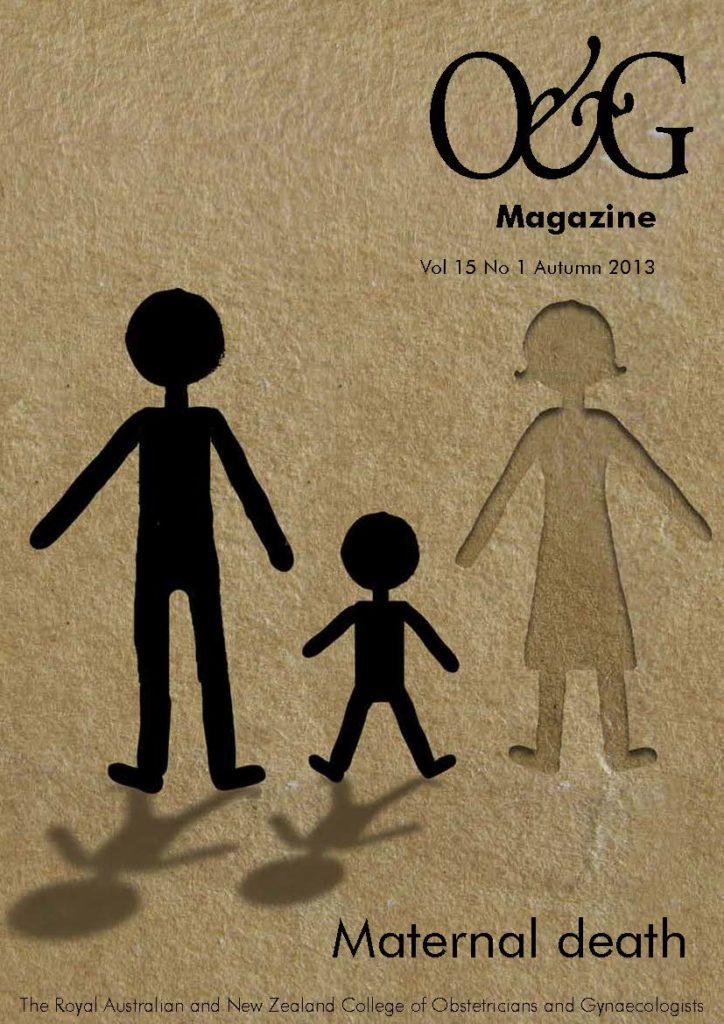We have come a long way in the six years since maternal death investigation was reinstated in New Zealand.
The recent history of maternal mortality investigations in New Zealand has been outlined in previous issues of O&G Magazine.1,2
Under the New Zealand Public Health & Disability Act 2000, authority was given to set up mortality committees. These now are four in number: Child and Youth; Perinatal and Maternal; Family Violence; and Perioperative. Initially, the mortality committees reported to the Minister of Health, but since 2010 they have reported to the Health, Quality and Safety Commission (HQSC).
In 2006, the Perinatal and Maternal Mortality Review Committee (PMMRC) established the Maternal Mortality Review Working Group, a multidisciplinary group – including obstetrics, midwifery, anaesthetics, obstetric medicine, pathology, psychiatry and a health manager – to look at maternal deaths. When the working group started, there had been no in-depth review of maternal deaths in New Zealand since 1996, when the then Maternal Deaths Assessment Committee reported on the triennium 1989–91. The working group reports to the PMMRC, which in turn reports to the HQSC, which then advises the Minister of Health.
The PMMRC set up a network of local coordinators in all district health boards to identify and notify cases. Deaths are also drawn to the PMMRC’s attention by clinicians, the Coronial Service, media reports, death notices and by cross-referencing notified deaths with the mortality collection of Births, Deaths and Marriages. Previous reports reported delay in identification, or non-identification, of cases. It is believed that currently the ascertainment of cases in New Zealand is as complete as it can be. Information is collected by review of notes, by a comprehensive maternal death data form and reports of individual practitioners. Where available coronial findings and any serious or sentinel event investigations, or internal enquiries are also reviewed. The cases are reviewed in detail by at least two members of the working group and all cases then come for discussion at the working group meetings, which are held three times a year. Following the review of cases, contributory factors are identified and potential avoidability is determined.
Table 1. Maternal mortality ratio (per 100 000 maternities) and cause of maternal death 2006–10.
| Classification and cause of maternal death | 2006 | 2007 | 2008 | 2009 | 2010 | 2006-2010 | ||
|---|---|---|---|---|---|---|---|---|
| n | n | n | n | n | n | % | Ratio (95% CI) | |
| Direct maternal death | 6 | 5 | 4 | 5 | 1 | 21 | 37 | 6.5 (4.1–10.0) |
| Amniotic fluid embolism | 3 | – | 1 | 4 | 1 | 9 | ||
| Postpartum haemorrhage | 1 | 1 | 1 | – | – | 3 | ||
| Pulmonary embolism | – | 1 | 1* | – | – | 2 | ||
| Peripartum cardiomyopathy | – | 1 | – | – | – | 1 | ||
| Pre-eclampsia/eclampsia | 2 | 1 | 1 | 4 | ||||
| Sepsis | 2 | – | – | – | – | 2 | ||
| Indirect maternal death | 7 | 5 | 5 | 9 | 7 | 33 | 58 | 10.3 (7.1–14.4) |
| Pre-existing medical condition | 2 | 4 | 2 | 1 | 2 | 11 | ||
| Non-obstetric sepsis | – | 1 | – | 5 | 1 | 7 | ||
| Intracranial haemorrhage | 1 | – | – | – | 1 | 2 | ||
| Suicide | 4 | – | 3 | 3 | 3 | 13 | ||
| Unclassifiable | 2 | 1 | – | – | – | 3 | 5 | 0.94 (0.19–2.7) |
| Total | 15 | 11 | 9 | 14 | 8 | 57 | 17.8 | |
| *Pulmonary embolism and sepsis | (13.5–23.0) | |||||||
The PMMRC now has accumulated data for the five years 2006–10 and these data were reported in June 2012, with the release of the PMMRC Sixth Annual Report.3 Work is well underway for reporting 2011 deaths and this report should be available for publication in the middle of 2013.
In the five-year period 2006–10, 57 deaths were recorded, giving a maternal mortality ratio of 17.8 (95% CI 13.5-23) per 100 000 maternities. The three leading causes of maternal death in New Zealand in this five-year period were suicide, pre-existing medical conditions and amniotic fluid embolism. Contributing factors were identified in 53 per cent of deaths and 32 per cent of deaths were thought to be potentially avoidable.4 These included contributory factors relating to organisational and/or management (32 per cent of deaths), relating to personnel (30 per cent of deaths) and barriers to access to, or engagement with, care (37 per cent of deaths). The most frequent barriers recorded were no or infrequent antenatal care, late booking and lack of recognition of the complexity or seriousness of a condition by the woman or her family.
In 2006–10, Maori and Pacific mothers were more likely than New Zealand European mothers to die in pregnancy or in the first six weeks postpartum. The estimate for Indian mothers was also higher than for New Zealand mothers, but this difference was not statistically significant.
Some issues are common to all maternal death reports from similar countries. Suicide was an unexpected leading cause of maternal death. There were 13 cases and, in addition, a further four late postpartum suicide deaths (from 42 days to one year) were reviewed, (even though these cases do not contribute to the maternal mortality ratio). Of the 13 deaths within the New Zealand definition of maternal mortality, seven occurred during pregnancy and six postpartum or post-termination of pregnancy. Eleven of the 13 deaths from suicide were by violent means. Over half had a history of alcohol or drug usage that included, in four, use at the time of death. It was noted that there were difficulties in providing appropriate care to women when information was kept by different organisations or practices, and where that information was not available to other practitioners involved in the woman’s care. Following these reviews, the PMMRC recommended the development of a comprehensive perinatal and infant mental health service aimed at reducing maternal mortality and morbidity. A comprehensive perinatal and infant mental health service includes:
- screening and assessment;
- timely interventions, including case management, transition planning and referrals;
- access to respite care and specialist inpatient care for mothers and babies; and
- consultation and liaison services within the health system and with other agencies, for example, primary care and termination of pregnancy services.
The PMMRC has also recommended that a mother and baby unit be provided in the North Island of New Zealand. One of the earliest workshops held by the PMMRC focused solely on maternal mental health issues, and it has been on the program of subsequent workshops. A recent Ministry of Health report titled ‘Healthy Beginnings: developing perinatal and infant mental health services in New Zealand’ (published January 2012) also highlighted the need for a mother and baby unit in the North Island and an analysis of current maternal health services in the Auckland Region is in the process of reporting on this recommendation.
There were a number of coincidental deaths in 2006–11, six of which were due to motor vehicle crashes. The committee felt that four of these six deaths were potentially avoidable had seat belts been worn and, as a result, a poster demonstrating wearing of seat belts in pregnancy has been developed and is available from the HQSC.
There are a number of parallel processes in investigation of maternal deaths. Local review of maternal deaths is important and valuable, particularly in looking for correctable systemic contributing causes where these are present, but is done variably depending on locality. The coronial process operates to its own recently revised legislation. (Deaths that must be reported to the Coroner include any death that occurred while the woman concerned was giving birth, or that appears to have been a result of that woman being pregnant or giving birth.) While accident compensation legislation has largely removed liability in tort, there still may be an investigation by the Accident Compensation Corporation to see if cover is available. The Health & Disability Commissioner has a parallel, but different, role in investigation of health complaints. Finally, there is the potential for referral to the Health Practitioners Disciplinary Tribunal and, ultimately, regulatory bodies.
The PMMRC holds a national workshop when the PMMRC Report is released. This year’s workshop will be held at Te Papa in Wellington on 12 June.
Is the PMMRC reporting worthwhile?
In late 2012, the HQSC commissioned a survey of health professionals regarding readership and usage of the Sixth Annual Report of the PMMRC reporting 2010 perinatal data and 2006–10 maternal data. Although the sample was small, all rated the report ‘very’ or ‘quite’ helpful in raising awareness about perinatal and maternal mortality; as a tool to inform practice, 97 per cent rated the report ‘very’ or ‘quite’ helpful; and, as a tool to influence change, 56 per cent rated the report ‘very helpful’ and 31 per cent ‘quite helpful’.
The full report and further information on the PMMRC can be found on the HQSC website.
References
- Haslam Alastair. Maternal mortality in New Zealand O&G Magazine 2009;11(1) 23.
- Haslam Alastair. Update on maternal deaths in New Zealand O&G Magazine 2009;11(2) 44.
- The Sixth Annual Report of the Perinatal and Maternal Mortality Review Committee https://www.hqsc.govt.nz/our-programmes/mrc/pmmrc/ publications-and-resources/publication/479/.
- Cynthia Farquhar, Lynn Sadler, Vicki Masson, Alastair Haslam. Beyond the numbers: classifying contributory factors and potentially avoidable maternal deaths in New Zealand, 2006-2009. Am J Obstet Gynecol 2011;205:331.e1-8.
Acknowledgements
Special thanks to Lynn Sadler and Vicki Masson in the preparation of this paper.
The maternal working group has comprised Alastair Haslam (Chair MMRWG), Claire McLintock, Jacqui Anderson, Alison Eddy, Cynthia Farquhar (Chair PMMRC), Cathy Hapgood, Jeanette McFarlane, John Walker, Graham Sharpe, Alec Ekeroma, Molly Wilson, Kate White, Elizabeth McDonald, Sue Belgrave. The national coordinator of PMMRC is Vicki Masson.






